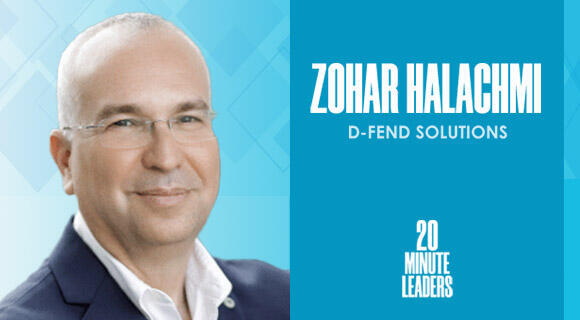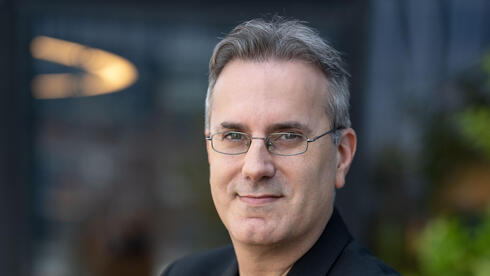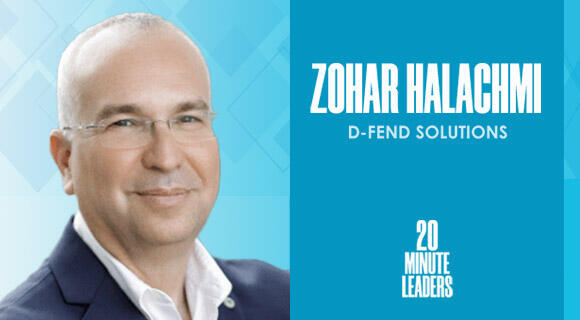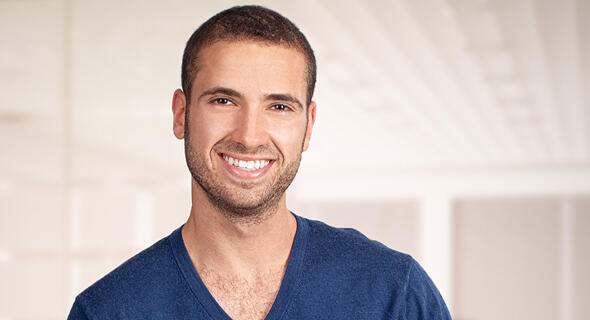
20-Minute Leaders
“We developed technology to identify and locate hostile drones, and we take control of them.”
With the increased availability of drones comes more risk that they will be used in dangerous or malicious ways, says Zohar Halachmi, co-founder and CEO of D-Fend Solutions
With the increased availability of drones comes more risk that they will be used in dangerous or malicious ways, says Zohar Halachmi, co-founder and CEO of D-Fend Solutions. But the early solutions for flying threats were meant for large aircraft or they carried risk of collateral damage. D-Fend Solutions created the technology to detect hostile drones and take control of them, leaving other drones and communication systems untouched. Halachmi shares that their work saved the Pope during an event, and most people had no idea there was almost an incident. As the threats evolve, D-Fend’s solution needs to keep up. The company culture of believing that they can deal with everything and that innovation allows the impossible to happen is key to their success, Halachmi explains. This is his first venture into the drone space, but he enjoys moving into a new type of business with each career move.
Tell me a little bit about yourself. What has been the guiding north star for you as you've been transitioning through the different companies you've worked with?
I grew up in Israel. I joined the Technion and I had my first degree there, and then I moved to Tel Aviv University. Then I started my career. I started with big companies and then with startups. Most of my business life was in the US at that time. I also had some time in the AsiaPac region.
Eventually, you're getting into the drone space. How does one transition to working in something like D-Fend Solutions six years ago?
If you look at my career, I never really did the same thing. My first activity was DSL. The second one was SaaS for enterprises. Third one was mobile advertisement. And this is the fourth one. Every time, I just move into a different type of business and technology. This is really what I like in what I do as an entrepreneur.
I think there are two kinds of entrepreneurs. There are those that come with the technology, and they try to find a need for this technology. And those that are trying to find a need and to develop a technology for that specific need. I am from the second type.
The need I found is this type of dealing with drones. We're actually protecting ourselves from drones. That's exactly what I'm trying to do. The drone society is a very important one. It's really the future of many things. What we try to do is support the growth of this society and secured drone adoption while providing innovation and technology to support it.
What is happening with drone technologies around the world today?
When we speak about drones, we each have a different picture in our head. Some of us see Amazon bringing stuff to our home with drones. Some of us see pizza coming. Others are using that in different malicious ways.
If you look about 10 years ago, you used to have to buy or invest $50 to $100 million dollars to get this kind of equipment. Right now, for $1,500, you can order yourself a drone that really can give you amazing capabilities. Connect to that a very powerful camera that is coming pre-integrated, and you get yourself a very sophisticated camera flying around you very easily and quickly. This is really the big change.
What I'm hearing from that is this decentralization of drones that perhaps one day could be weapons or have any tools that can be used in ways we don't want them to, that is a risk we have to address. It's no longer specific armies or groups that we know are purchasing these, but you now have a decentralization and we don't have much control over it. Right?
That's correct. Some of that is coming from malicious types of usage, and some of that is coming just from the inability of the people that use it to understand the danger and what really can happen if they use it in the wrong way. If you try to use these types of drones next to airports and you try to take a very cool picture of any kind of plane taking off, that's dangerous.
In what tangible scenarios can we imagine a company like D-Fend Solutions becoming extremely relevant? What are we actually defending against?
I'll give you several scenarios. Think about the Gatwick event (in 2018) where the airport was shut down for nearly 72 hours.
Another, if you think about VIP locations, whether this is Buckingham Palace, the White House, or the Japanese Prime Minister office: all of those were locations where people landed drones next to them or on them. Most of them were not actually terrorists. But this is a very important place to protect yourself as well.
Another one, prisons. Drones are the most popular and very easy way to smuggle narcotics, mobile devices, ammunition and other equipment into prisons. Sports events and crowd-based events: you don't want a drone to fly over your head when you watch the Super Bowl.
And you don't want any kind of drone to take the IP rights of any organization that acquired these IP rights for money. It's not just safety, it's not just security, it's also IP rights.
Take me back to 2016. Where was D-Fend Solutions coming into play? What is the thesis that you come in and say, "I want to do this"?
When we started, we evaluated all the different technologies available in the market to deal with drones. We found out that the traditional type used for big aircraft is the one being utilized against drones. They don't really fit the current situation. If you want to try and protect yourself from drones inside Manhattan or protect the Pope, you cannot use a radar to identify these drones. That goes for detection.
If you try to understand the mitigation part of that, at the end there were two types of mitigation available: kinetic solutions, meaning everything that flies very fast and makes a big or a small boom at the end; and the jammers, GPS jammers, WIFI jammers, communication jammers, GPS spoofers, and the collateral damage of those is huge.
This is a real case that we released about three months ago: we saved the Pope in a real event. You cannot fire a missile over there. If you're going to jam, you're going to have an impact on all the communication in that environment.
We came with the understanding that we need to develop something else that will enable law enforcement and people that are trying to protect in these kinds of locations. We developed the technology that enables us to identify, track, and locate these drones using the communication that these drones have, and we take control of the hostile drones, with no collateral damage at all. We have no impact on any other drones flying there or other communications running there. It's a really safe solution to control this problem.
I like to say that we take a drone incident and we verify that it's not going to become an incident at all. The Pope case is a classic example. Nobody actually knew that we were very close to having a drone incident there. And nothing happened.
From a technological and innovative perspective, this cat and mouse game of new technologies arising for drones, how do you as the company make sure that you're constantly at the forefront of the technology?
The understanding that this is a cat and mouse game is a very important one. Many other types of solutions are ones that you give to the customer, and that's the solution until the rest of the life of that equipment. That's not a viable solution in the drones world. You must have this ability to upgrade and update the product all the time.
I think that the best analogy is your antivirus on your computer. We need to have this antivirus updated all the time to deal with the new viruses. What we did was to develop a methodology to do exactly that. We just release updates and we verify that we deal with the most advanced types of threats.
How are you creating a culture of continuous curiosity, innovation, and advancement that allows the company to have that mentality?
First, I call it "make it happen." We always can deal with everything. This is part of the DNA of the company. And innovation, bottom line, really achieves the impossible. We try to think about all of these problems in an innovative way to find an innovative technology to deal with that.
Michael Matias, Forbes 30 Under 30, is the author of Age is Only an Int: Lessons I Learned as a Young Entrepreneur. He studies Artificial Intelligence at Stanford University, is a Venture Partner at J-Ventures and was an engineer at Hippo Insurance. Matias previously served as an officer in the 8200 unit. 20MinuteLeaders is a tech entrepreneurship interview series featuring one-on-one interviews with fascinating founders, innovators and thought leaders sharing their journeys and experiences.
Contributing editors: Michael Matias, Megan Ryan















